Are you curious about your feline friend’s ancestry? Discovering “How Can I Figure Out What Breed My Cat Is” can be an exciting journey. At solcat.net, we help you explore the unique characteristics and lineage of your beloved pet, providing you with insights to better understand and appreciate your cat. Knowing your cat’s breed can influence everything from their dietary needs to understanding breed-specific health issues.
1. Understanding Your Cat’s Physical Traits: Size and Weight
Is your cat a petite powerhouse or a gentle giant? The size and weight of your cat are fundamental clues in figuring out their breed. Cats vary dramatically in size, ranging from the diminutive dwarf breeds to the impressive Maine Coons.
1.1. Large Cat Breeds
Cats weighing over 15 pounds are generally considered large. These aren’t just heavy cats; they’re also long and tall, often standing over 8 inches tall and reaching lengths of up to 47 inches.
Common Large Cat Breeds:
| Breed | Weight Range (lbs) | Notable Traits |
|---|---|---|
| Maine Coon | 15-25+ | Long fur, bushy tail, friendly demeanor |
| Norwegian Forest Cat | 12-20 | Thick double coat, adaptable to cold climates |
| Ragdoll | 10-20 | Blue eyes, semi-long fur, docile temperament |
| Siberian | 10-20 | Hypoallergenic coat, playful and affectionate |
| Turkish Van | 10-20 | Water-loving, semi-long fur, intelligent |
1.2. Medium-Sized Cat Breeds
 A sleek Siamese cat sitting gracefully, exemplifying the typical size and elegance of medium breeds
A sleek Siamese cat sitting gracefully, exemplifying the typical size and elegance of medium breeds
Most cat breeds fall into the medium-sized category, typically weighing between 9 and 12 pounds. This category is broad, so size alone may not pinpoint the breed but is still a valuable piece of the puzzle.
Common Medium-Sized Cat Breeds:
| Breed | Weight Range (lbs) | Notable Traits |
|---|---|---|
| Siamese | 8-12 | Striking blue eyes, vocal, intelligent |
| Abyssinian | 8-12 | Ticked coat pattern, active and curious |
| American Shorthair | 8-15 | Adaptable, friendly, classic tabby markings |
| Burmese | 8-12 | Affectionate, playful, golden eyes |
| Russian Blue | 7-12 | Silver-blue coat, green eyes, reserved demeanor |
1.3. Small or Dwarf Cat Breeds
If your cat is smaller than 9 pounds and fully grown, it’s likely a small or dwarf breed. These cats are relatively easy to identify due to their distinctive size.
Common Small or Dwarf Cat Breeds:
| Breed | Weight Range (lbs) | Notable Traits |
|---|---|---|
| Munchkin | 4-9 | Short legs, playful, outgoing |
| Singapura | 5-8 | Large eyes, ticked coat, curious and active |
| Cornish Rex | 6-10 | Curly coat, slender body, affectionate |
2. Decoding Facial Features: Understanding Face Shapes
The shape of your cat’s face can provide significant clues about its breed. Some cats have distinctive facial structures that make them easier to identify.
2.1. Round and Flat-Faced Cats (Brachycephalic)
Brachycephalic breeds have shorter skulls, giving them a flattened appearance. This trait can lead to specific health concerns, such as breathing difficulties and dental problems. According to the American Animal Hospital Association (AAHA), choosing a reputable breeder can mitigate some health risks associated with this trait.
Common Round or Flat-Faced Cat Breeds:
| Breed | Notable Traits | Health Considerations |
|---|---|---|
| Persian | Long, flowing fur, sweet temperament | Breathing issues, tear duct problems, polycystic kidney disease |
| Exotic Shorthair | Short, dense fur, round face, gentle demeanor | Breathing issues, tear duct problems, polycystic kidney disease |
| Himalayan | Blue eyes, color points, long fur | Breathing issues, tear duct problems, polycystic kidney disease |
2.2. Narrow-Faced Cats
Narrow-faced cats have triangular faces, often with high cheekbones and a sleek appearance.
Common Narrow-Faced Cat Breeds:
| Breed | Notable Traits |
|---|---|
| Siamese | Slender body, blue almond-shaped eyes |
| Oriental Shorthair | Large ears, athletic build |
| Cornish Rex | Curly coat, large ears |
3. Examining the Ears: Shapes, Tufts, and Folds
The shape of your cat’s ears can be a telling sign of its breed. Certain breeds have distinct ear shapes due to genetic mutations.
3.1. Curled Ears
Curled ears arch backward, almost like small horns.
Cat Breeds with Curled Ears:
| Breed | Notable Traits |
|---|---|
| American Curl | Playful, affectionate, unique ear shape |
3.2. Folded Ears
Folded ears are caused by a genetic mutation affecting cartilage, which can lead to health issues.
Cat Breeds with Folded Ears:
| Breed | Notable Traits | Health Considerations |
|---|---|---|
| Scottish Fold | Sweet temperament, folded ears, potential for arthritis | Cartilage abnormalities, arthritis, potential deafness |
3.3. Tufted Ears, Lynx Tips, or Ear Furnishings
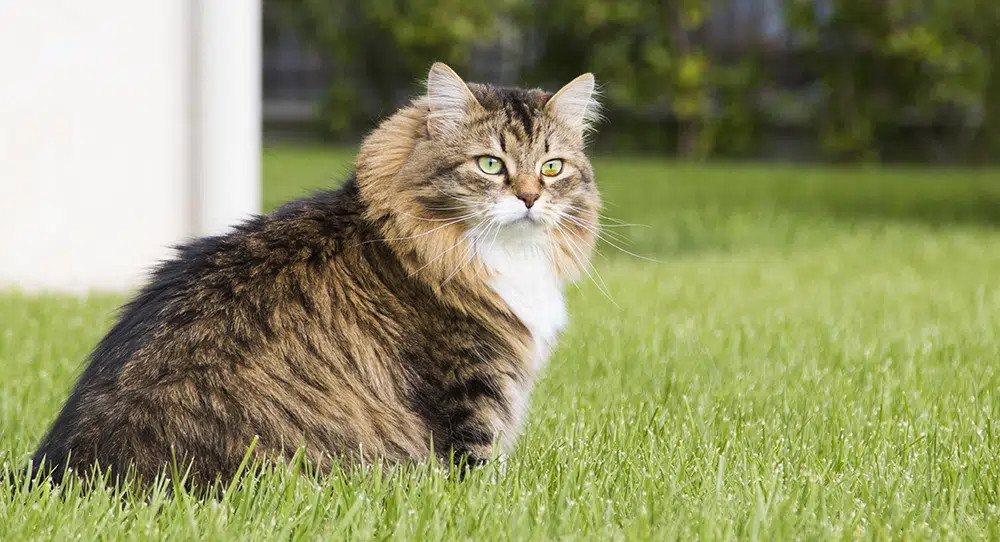 A beautiful brown tabby Siberian cat sitting on the grass, showing off its ear tufts
A beautiful brown tabby Siberian cat sitting on the grass, showing off its ear tufts
Ear tufts (lynx tips) are tufts of fur growing from the tips of the ears, while ear furnishings are hairs inside the ears.
Cat Breeds with Ear Tufts:
| Breed | Notable Traits |
|---|---|
| Maine Coon | Large size, long fur, friendly demeanor |
| Norwegian Forest Cat | Thick double coat, adaptable to cold climates |
| Siberian | Hypoallergenic coat, playful and affectionate |
4. Observing Eye Color: A Window to Breed Identity
Eye color can also provide clues. While many cats have common eye colors like amber, hazel, gold, green, or blue, some breeds exhibit unique variations, including heterochromia (different colored eyes).
Cat Breeds with Rare Eye Colors:
| Breed | Notable Traits |
|---|---|
| Turkish Van | Water-loving, often displays heterochromia |
| Angora | Elegant, silky coat, can have heterochromia |
| Sphynx | Hairless, can have striking eye colors |
5. Analyzing Coat Characteristics: Length, Texture, and Pattern
Your cat’s coat is another crucial piece of the puzzle. Consider the length, texture, and any unique patterns.
5.1. Longhaired Cats
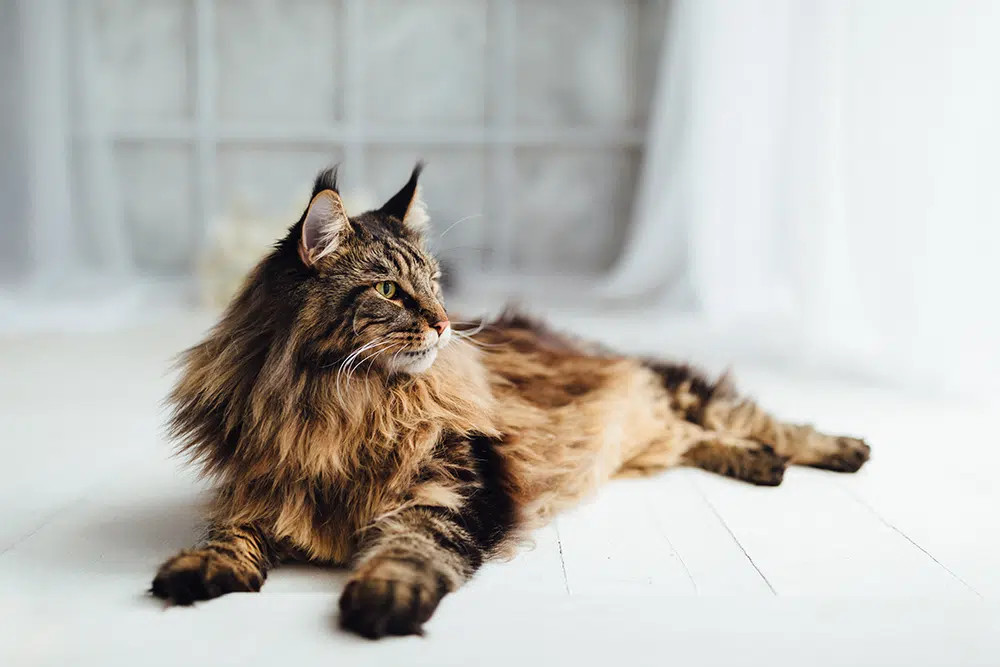 A stunning smoked longhaired Maine Coon cat lying indoors, displaying its luxurious long coat
A stunning smoked longhaired Maine Coon cat lying indoors, displaying its luxurious long coat
Longhaired cats have fluffy coats and require regular grooming.
Long-Haired Cat Breeds:
| Breed | Notable Traits |
|---|---|
| Maine Coon | Large size, bushy tail, friendly |
| Persian | Flat face, long flowing fur, sweet |
| Ragdoll | Blue eyes, semi-long fur, docile |
| Siberian | Hypoallergenic coat, playful |
| Norwegian Forest Cat | Thick double coat, adaptable |
5.2. Shorthaired Cats
Shorthaired cats have short fur close to their bodies, requiring less grooming.
Short-Haired Cat Breeds:
| Breed | Notable Traits |
|---|---|
| Siamese | Striking blue eyes, vocal, intelligent |
| Abyssinian | Ticked coat pattern, active, curious |
| British Shorthair | Round face, dense coat, calm |
| American Shorthair | Adaptable, friendly, classic tabby |
| Bengal | Rosetted coat, athletic, energetic |
5.3. Curly-Haired Cats
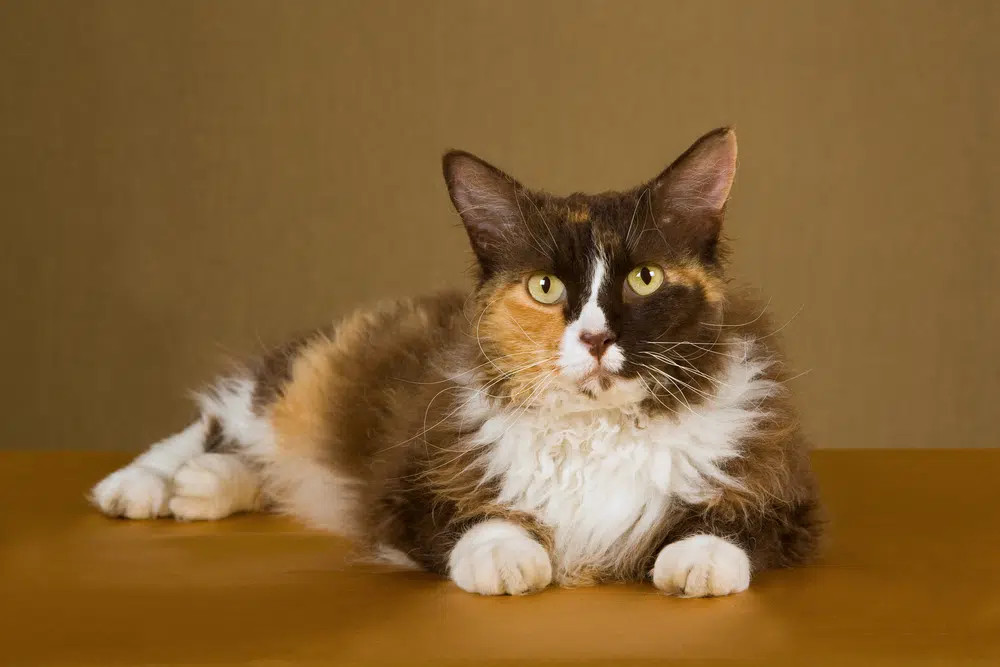 A beautiful LaPerm tri-colored cat, showing off its distinctive curly coat
A beautiful LaPerm tri-colored cat, showing off its distinctive curly coat
Curly-haired cats have unique, wavy coats that require special care.
Curly-Haired Cat Breeds:
| Breed | Notable Traits |
|---|---|
| Cornish Rex | Slender body, large ears |
| LaPerm | Outgoing, affectionate |
| Selkirk Rex | Dense, plush coat, gentle |
5.4. Hairless Cats
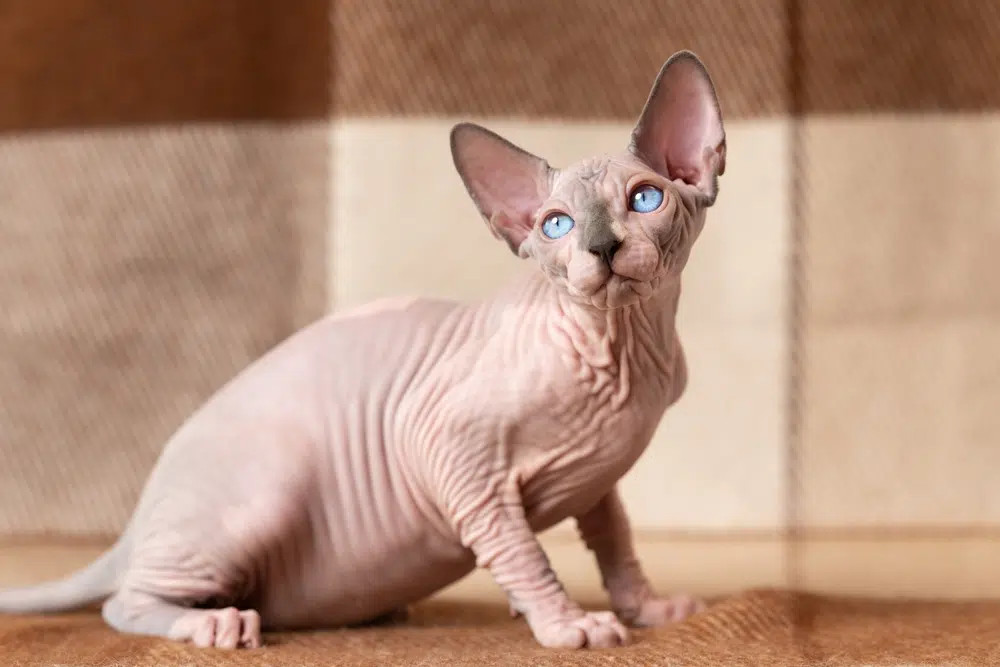 A curious Sphynx cat sitting on a blanket, displaying its unique hairless appearance
A curious Sphynx cat sitting on a blanket, displaying its unique hairless appearance
Hairless cats have a distinctive look and are popular among allergy sufferers.
Hairless Cat Breeds:
| Breed | Notable Traits |
|---|---|
| Sphynx | Wrinkled skin, large ears, affectionate |
| Donskoy | Hairless or suede-like coat |
| Peterbald | Hairless or short, velvety coat |
6. Identifying Colors, Patterns, and Markings: The Feline Palette
Coat color and pattern can provide additional clues. Some breeds have specific colors or patterns that are characteristic of the breed.
6.1. Solid Color
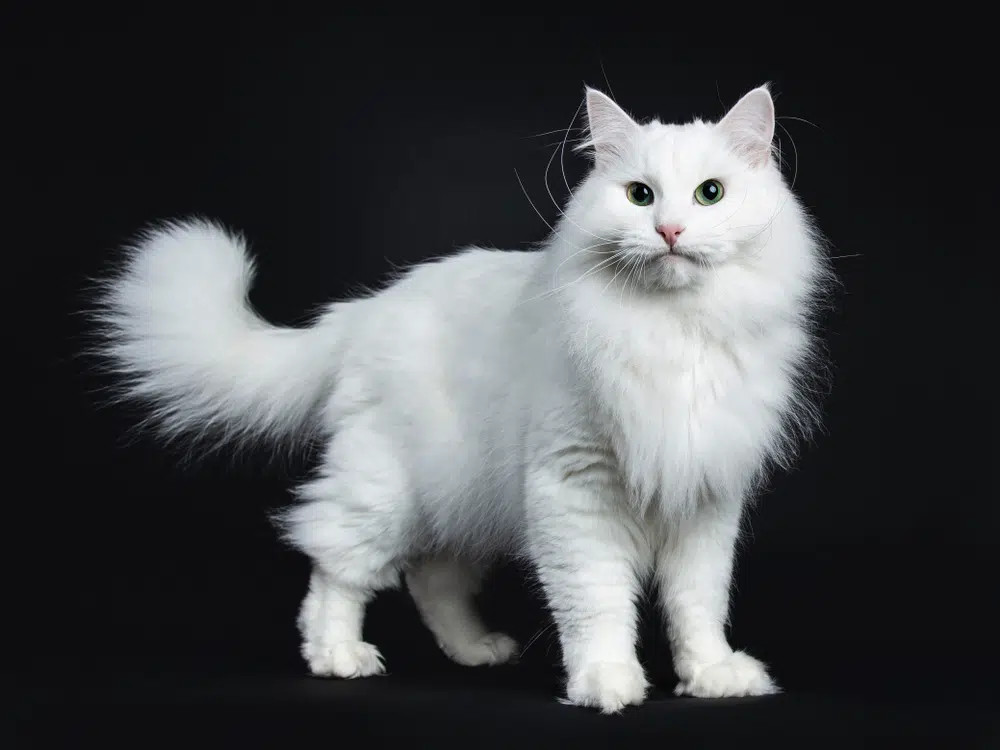 A pristine pure white Siberian cat, illustrating a solid color coat
A pristine pure white Siberian cat, illustrating a solid color coat
Cats with a single, uniform color are considered solid-colored.
6.2. Bi-Color
 A playful blue tabby Maine Coon cat running, showcasing a bi-color coat
A playful blue tabby Maine Coon cat running, showcasing a bi-color coat
Bi-colored cats have a base color with white patches.
Many breeds can have bi-colored coats, such as:
| Breed | Colors |
|---|---|
| Maine Coon | White with black, blue, red, cream |
| American Shorthair | White with tabby patterns |
| Turkish Van | White with colored head and tail |
6.3. Tortoiseshell
Tortoiseshell cats have patches of different colors mixed together, without white.
6.4. Calico
Calico cats have three colors: white, along with two other colors.
6.5. Points
Pointed cats have darker coloration on their face, feet, ears, and tail.
Color-Pointed Cat Breeds:
| Breed | Colors of Points |
|---|---|
| Siamese | Seal, blue, chocolate, lilac |
| Himalayan | Seal, blue, chocolate, lilac, red, cream |
| Ragdoll | Seal, blue, chocolate, lilac |
7. Examining Tail Length: Long or Short
Variations in tail length can also help narrow down your search.
7.1. Short Tails
Short tails can be a significant clue.
Short Tailed Cat Breeds:
| Breed | Notable Traits |
|---|---|
| Manx | Tailless or short tail, playful, dog-like |
| Japanese Bobtail | Short, pom-pom tail, active, vocal |
| American Bobtail | Flexible, expressive tail, adaptable |
8. Understanding Behavior: Temperament and Traits
While individual cats have unique personalities, certain behavioral traits are common among specific breeds.
8.1. Smart Cat Breeds
Intelligent breeds are often quick learners and enjoy puzzle toys.
Intelligent Cat Breeds:
| Breed | Notable Traits |
|---|---|
| Abyssinian | Curious, playful, easily trained |
| Bengal | Energetic, intelligent, enjoys climbing |
| Siamese | Vocal, intelligent, demands attention |
| Burmese | Affectionate, playful, learns tricks |
| Cornish Rex | Active, intelligent, loves to play fetch |
8.2. Noisy Cat Breeds
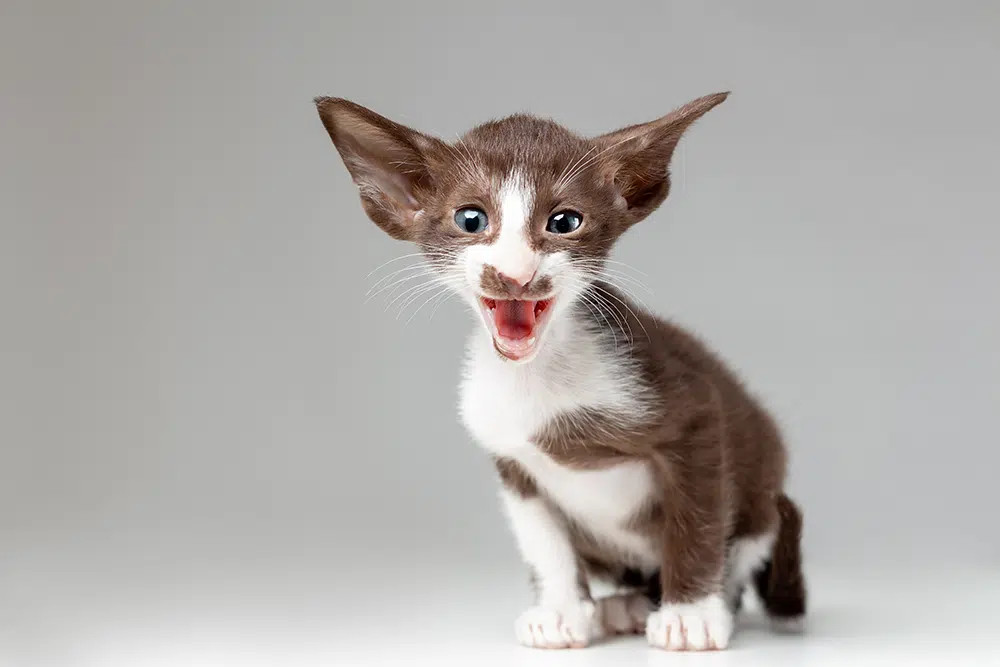 An adorable bicolor Oriental cat kitten, known for its vocal nature
An adorable bicolor Oriental cat kitten, known for its vocal nature
Vocal breeds communicate frequently with their owners.
Vocal Cat Breeds:
| Breed | Notable Traits |
|---|---|
| Siamese | Loud, communicative, demands attention |
| Oriental Shorthair | Vocal, curious, affectionate |
| Burmese | Social, vocal, loves interaction |
8.3. Calm and Docile Cat Breeds
Docile breeds are relaxed and enjoy quiet environments.
Docile Cat Breeds:
| Breed | Notable Traits |
|---|---|
| Ragdoll | Gentle, relaxed, enjoys cuddling |
| Persian | Sweet, quiet, enjoys being pampered |
| British Shorthair | Calm, affectionate, easygoing |
8.4. Friendly Cat Breeds
Friendly breeds are sociable and enjoy interacting with people.
Friendly Cat Breeds:
| Breed | Notable Traits |
|---|---|
| Ragamuffin | Affectionate, gentle, good with children |
| Burmese | Social, playful, loves interaction |
| Maine Coon | Friendly, adaptable, good with families |
8.5. Independent Cat Breeds
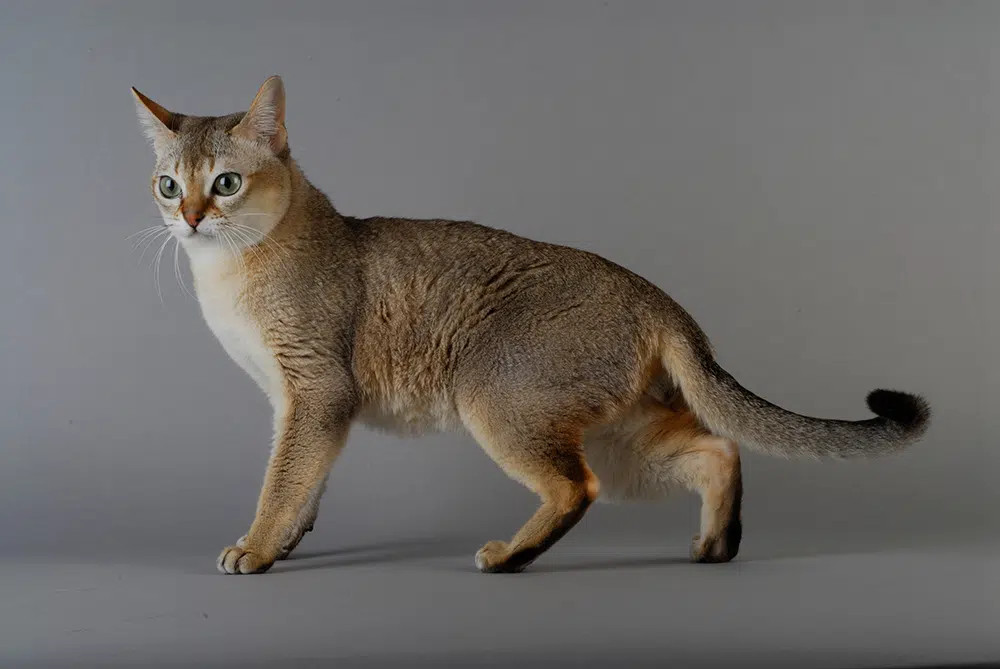 A poised Singapura cat against a grey background, exemplifying its independent nature
A poised Singapura cat against a grey background, exemplifying its independent nature
Independent breeds are self-sufficient and don’t require constant attention.
Independent Cat Breeds:
| Breed | Notable Traits |
|---|---|
| Singapura | Curious, active, but independent |
| Russian Blue | Reserved, quiet, enjoys solitude |
| Turkish Van | Intelligent, active, but can be independent |
8.6. Cat Breeds That Like Water
Water-loving breeds enjoy playing in or around water.
Water-Loving Cat Breeds:
| Breed | Notable Traits |
|---|---|
| Turkish Van | Enjoys swimming, playful, active |
| Maine Coon | Water-resistant coat, curious about water |
| Bengal | Enjoys playing in water, athletic, energetic |
9. Combining the Clues: How to Determine Your Cat’s Breed
To determine your cat’s breed, combine all the information you’ve gathered about its physical traits and behavior. Search online using specific traits like “calm, large, short fur, tan cat breed” to find potential matches.
9.1. Utilizing Breed Lists
Refer to the breed lists provided in each section. If a particular breed appears consistently across all the traits your cat displays, it’s highly likely your cat belongs to that breed. Keep in mind that mixed-breed cats may exhibit traits from multiple breeds.
10. Genetic Testing: The Definitive Answer
For 100% certainty about your cat’s breed, consider genetic testing. These tests analyze your cat’s DNA to determine their genetic makeup, providing an accurate answer about their breed or breeds. Genetic testing can also reveal potential health concerns. Cornell Feline Health Center research indicates that genetic testing can identify predispositions to certain diseases, enabling proactive care.
11. Visit solcat.net: Your Ultimate Resource for Cat Lovers
At solcat.net, you can find in-depth breed profiles, care tips, and a vibrant community of cat enthusiasts.
Why Visit solcat.net?
- Comprehensive Breed Guides: Detailed information on various cat breeds.
- Expert Advice: Tips on cat care, health, and behavior from veterinarians and feline experts.
- Community Forum: Connect with other cat lovers, share experiences, and ask questions.
- Latest Research: Updates on feline health and behavior from leading research institutions.
FAQ: Unlocking the Mystery of Your Cat’s Breed
1. How accurate are online breed identifiers for cats?
Online breed identifiers can provide a starting point, but they are not always accurate. Physical traits and behavior can be influenced by multiple breeds in mixed-breed cats, making online tools less reliable than genetic testing.
2. Can a vet tell me what breed my cat is?
A vet can offer insights based on their expertise and knowledge of cat breeds, but they cannot definitively determine a cat’s breed without genetic testing. Vets can identify physical characteristics and potential breed-related health issues.
3. What are the benefits of knowing my cat’s breed?
Knowing your cat’s breed can help you understand its specific needs, potential health issues, and behavioral tendencies. This knowledge can inform your cat’s diet, exercise, and healthcare decisions.
4. Is it possible for a cat to be a mix of more than two breeds?
Yes, it’s possible for a cat to be a mix of multiple breeds, especially in stray or rescue cats. Genetic testing can reveal a complex mix of ancestral breeds.
5. How much does cat DNA testing cost?
Cat DNA testing typically ranges from $99 to $199, depending on the level of detail provided in the results. Some tests focus on breed identification, while others include health screenings.
6. Are there specific behaviors that are unique to certain cat breeds?
Yes, some behaviors are more common in certain breeds. For example, Siamese cats are known for being vocal, while Ragdolls are known for their docile temperament. However, individual personalities can vary.
7. Can coat color or pattern definitively identify a cat’s breed?
Coat color or pattern alone cannot definitively identify a cat’s breed. While some breeds have specific coat colors or patterns, these traits can also appear in mixed-breed cats.
8. How reliable are cat breed characteristics when determining a cat’s breed?
Cat breed characteristics provide valuable clues but should be considered in combination with other factors like size, face shape, and ear type. Individual cats may not perfectly fit the breed standard.
9. What should I do if I suspect my cat has a breed-specific health issue?
If you suspect your cat has a breed-specific health issue, consult your veterinarian. Early detection and treatment can improve your cat’s quality of life. Genetic testing can also help identify potential health risks.
10. Where can I find more information about different cat breeds?
You can find more information about different cat breeds on solcat.net, at your local library, or through reputable cat breed organizations like The International Cat Association (TICA) and the Cat Fanciers’ Association (CFA).
Conclusion: Discovering Your Cat’s Identity
Unlocking the mystery of your cat’s breed can be a rewarding experience. By carefully observing physical traits, behavior, and considering genetic testing, you can gain valuable insights into your feline friend’s ancestry. Visit solcat.net for more information and resources to help you on your journey.
Ready to delve deeper into the world of cats? Explore solcat.net today and connect with a community of passionate cat lovers! Learn more about your cat’s breed, health, and care needs. Join us and discover everything you need to know about your feline companion!
Address: 950 Alaskan Way, Seattle, WA 98104, United States
Phone: +1 (206) 386-4000
Website: solcat.net
